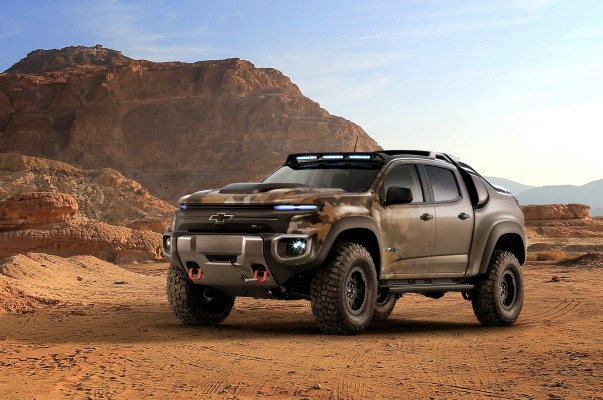Chevrolet continues work on zero-emission hydrogen fuel cell tech, and it’s now providing a just-revealed Colorado ZH2 fuel cell vehicle to the U.S. Army for design, to find out if the unique advantages of fuel cell tech are viable in actual real-world military mission situations.
The ZH2 is a modified version of the Colorado midsize pickup Chevrolet produces for the consumer market, with a specially reinforced frame designed for all-terrain use. The car’s engine compartment has also been modified to accommodate its hydrogen fuel-cell based power train, which GM says offers unique advantages for military use.
The U.S. Army’s testing will be focused on evaluating the benefits of fuel-cell tech in a number of areas, including “near-silent operation,” “reduced acoustic and thermal signatures,” “high wheel torque at all speeds,” “low fuel consumption across operating range,” and “water by-product for field uses.”
In everyday terms, that basically means that the Army will be checking out how the use of fuel cells might make for quieter, cooler rides that are harder to detect via instrument and human observation, and that can climb and tow with greater ease thanks to the continuous use of high torque which is a key ingredient of its hydrogen-powered electric drive train.
[gallery ids="1395864,1395866,1395867"]
The hydrogen cells used to power the test vehicle can also potentially be used to provide a power source for field equipment, and for encampments, which is definitely useful when in missions deep in territory otherwise devoid of human settlement. Plus, the byproduct produced by the fuel cells is water – a valuable commodity on extended, remote trips.
“One of the things we started testing about 10 years ago is this exportable power take-off,” explained GM Executive Director of Global Fuel Cell Activities Charlie Freese in an interview. “Whether you’re using the vehicle in a site where you have no access to plug-in power, or if you’re a camper, or if you’re in this military environment, the ability to export 25 kW continuous, or up to 50 kW at its peak, is a really great functionality that comes out of this fuel cell system.”
One of the longer-term benefits of the use of fuel cells in this context might be the flexibility of the power source, however – the very same fuel cell power system is being used in a trial with the U.S. Navy to power an unmanned submarine. Long-term, you could see the benefits of using a common power source to fuel any number of military vehicles across branches; swapping out units in the field would not only mean better economies of scale, but shared training across operational and support personnel, too.
“You can imagine when you’re supporting them in the field, and you have a deep cache of spare parts,” Freese explained. “I could be wrong, but I’m not so sure I could imagine taking the spare parts out of a Navy depot and immediately servicing an Army vehicle, but with this [fuel cell tech] you could actually do that.”
GM developed the Colorado ZH2 in partnership with the U.S. Army Tank automotive Research, Development and Engineering Center and the entire sprint from winning the contract to producing the concept unveiled today took less than a year. Internal GM preparation of the vehicle will continue earl into next year, at which time it’ll be handed over to the Army for a full year of field trial.
